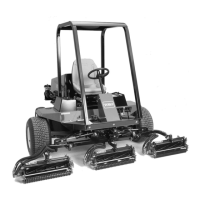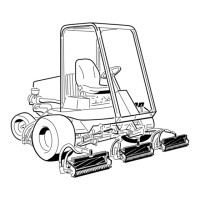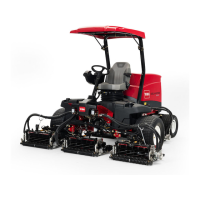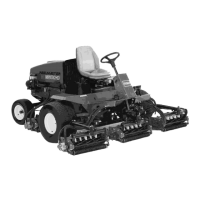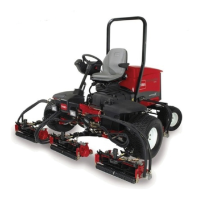Reelmaster 5010 Series Hydraulic System (Rev. C)Page 4 -- 9
Traction Circuit
The hydraulic traction circuit consists of a variable dis-
placementpistonpump(P5)connectedinaclosedloop,
parallelcircuittotwo(2)orbitalrollervanewheelmotors.
The traction pump input shaft is rotated by a drive shaft
that is driven from the engine flywheel.
Traction circuit pressure (forward and reverse) can be
measured at test ports located in the hydraulic tubes
that connect the front wheel motors.
Forward Direction (Fig. 8)
Pushing the top of the traction pedal angles the traction
pump swash plate to create a flow of oil. This oil flow is
directed to the wheel motors via hydraulic hoses and
tubes to drive the wheels in the forward direction. For-
ward traction pressure is limited to 3625 PSI (250 bar)
by the forward traction relief valve (R3) located in the
traction pump.
Oilflowingfromthewheelmotorsreturnstothevariable
displacement pump and is continuously pumped
through the traction circuit as long as the traction pedal
is pushed.
Theangleoftheswashplatedeterminespumpflowand
ultimatelytraction speed.When thetractionpedalisde-
pressedasmallamount,asmallswashplaterotationre-
sultsinlowpumpoutputandlowertractionspeed.When
the traction pedal is depressed fully, the pump swash
platerotates fullytoprovidemaximumpump outputand
traction speed.
Gearpumpsection(P3)suppliesoilflowforthesteering
circuitandalsoprovides a constant supply of c harge oil
to the closed loop traction circuit. This charge oil pro-
videslubricationfortractioncircuitcomponentsandalso
replenishes traction circuit oil that is lost due to internal
leakage in the traction circuit.
Gearpump(P3)takesitssuctionfromthehydraulicres-
ervoir.Chargepumpflow isdirectedtothelowpressure
side of the c losed loop traction circuit. Charge pressure
is limited by the charge relief valve (R5) located in the
tractionpump.Thechargereliefpressureis200PSI(14
bar).
The piston pump ( P5) includes a flushing valve (R10)
thatbleedsoffasmall amountofhydraulicfluid for cool-
ingoftheclosedlooptractioncircuit.Thechargesystem
replenishesoilthatisbledfromthetractioncircuitbythe
flushing valve.
Reverse Direction
The traction circuit operates essentially the same in re-
verse as it does in the forward direction. However, the
flow through the circuit is reversed. Pushing the bottom
of the traction pedal rotates the traction pump swash
plate to create a flow of oil. This oil is directed to the
wheel motors to drive the wheels in the reverse direc-
tion. Reverse traction pressure is limited to 3625 PSI
(250bar)bythereversetractionreliefvalve(R4)located
in the traction pump.
Oil flowing from the wheel motors returns to thetraction
pump and is continuously pumped through the closed
loop traction circuit as long as the traction pedal is
pushed.
Thecharge circuit and flushing valve (R10) functionthe
same in reverse as they do in the forward direction.
CrossTrax
TM
AWD (Optional)
On machines equipped with the optional CrossTrax
TM
AWD kit, four wheel motors are used (Fig. 9). Traction
pump flow is directed to the front tires and the opposite
rear tires to maximize traction. To reduce tire scuffing
when turning, traction system pressure is equalized in
theAWDmanifoldwithanorificeandabi--directionalre-
lief valve. Check valves in the AWD manifold allow the
rear wheel motors to over run during tight turns.
Figure 9
G5
CrossTrax AWD Hydraulic Schematic
TM
Hydraulic
System
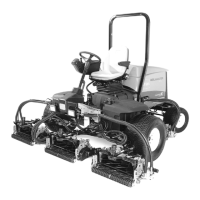
